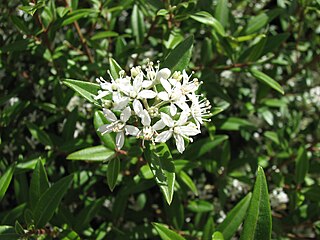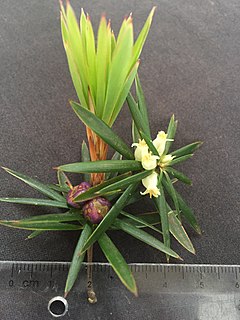
Eucalyptus globulus, commonly known as southern blue gum or blue gum, is a species of tall, evergreen tree endemic to southeastern Australia. This Eucalyptus species has mostly smooth bark, juvenile leaves that are whitish and waxy on the lower surface, glossy green, lance-shaped adult leaves, glaucous, ribbed flower buds arranged singly or in groups of three or seven in leaf axils, white flowers and woody fruit.

Olearia argophylla is a species of flowering plant in the family Asteraceae. Its common names are musk daisybush, musktree, muskwood and silvershrub. It is found in Australia, specifically in New South Wales, Tasmania and Victoria. It grows as a tall shrub or tree characteristic of wet sclerophyll forest. Its leaves are large and broad, coarsely toothed, green on top and silver-white underneath. The grain of the wood is mainly straight, but burls near the base of the tree are prized for their brown swirls that often suggest the appearance of small faces or animals peering out of the wood, making them highly sought after by woodworkers.

Gaultheria hispida, commonly known as the copperleaf snowberry, is an endemic eudicot of Tasmania, Australia. It is an erect multi-branched shrub, that can be found in wet forests and alpine woodlands. Its berries appear snowy white and leaves are tipped with a copper tinge, hence the common name.

Olearia phlogopappa commonly known as the dusty daisy-bush or alpine daisy-bush is a species of flowering plant in the family Asteraceae that is commonly found in eastern New South Wales, Victoria and Tasmania. It is a small shrub with greyish-green foliage, daisy-like flowers in white, pink or mauve that can be seen from spring to late summer.

Telopea truncata, commonly known as the Tasmanian waratah, is a plant in the family Proteaceae. It is endemic to Tasmania where it is found on moist acidic soils at altitudes of 600 to 1200 m (2000–4000 ft). Telopea truncata is a component of alpine eucalypt forest, rainforest and scrub communities. It grows as a multistemmed shrub to a height of 3 metres (10 ft), or occasionally as a small tree to 10 m (35 ft) high, with red flower heads, known as inflorescences, appearing over the Tasmanian summer and bearing 10 to 35 individual flowers. Yellow-flowered forms are occasionally seen, but do not form a population distinct from the rest of the species.

Gahnia grandis is a tussock-forming perennial plant found in southeastern mainland Australia and Tasmania.

Histiopteris incisa, the bat's wing fern, water fern or fern mata, is a common plant found in Australia, New Zealand and other islands in the south Pacific region. Usually found in moist areas, where it may form large colonies. The lowermost lobes of each pinnae have a bat wing like appearance, giving the fern its common name.

Nematolepis squamea , commonly known as Satinwood, is an upright shrub or small tree species which is endemic to Australia. The species was first formally described in 1805 and named Eriostemon squamea. It was transferred to the genus Phebalium in 1896 and subsequently to Nematolepis by Paul G. Wilson in 1998. The name is derived from the Greek words nematos 'thread', lepsis 'scale' and the Latin word squameus 'scaly' referring to the scales on the leaves, stems and stamens.

Persoonia muelleri, commonly known as Mueller’s geebung, is a shrub endemic to Tasmania. It forms a shrub in open areas of wet forests in the west and northeast of the state. It is occasionally confused with P. gunnii though it has larger flowers and longer, straighter leaves.

Cyathodes glauca, the purple cheeseberry, is a woody shrub or small tree common in Tasmania, Australia. It belongs to the 'heath' family, Ericaceae. 'Heath' refers to open, shrub-like communities which survive on well-drained and poor quality soils.

Pomaderris elliptica is a shrub species that is native to the Australian states of New South Wales, Victoria and Tasmania. Small yellow to pale yellow flowers appear between September and October in the species's native range. Two varieties are currently recognised:

Cenarrhenes is a monytypic genus in the family Proteaceae containing the single species Cenarrhenes nitida, known as the Port Arthur plum or native plum. Cenarrhenes nitida is an evergreen shrub to small tree endemic to the rainforests and scrublands of western Tasmania. It bears white flowers in late spring followed by the development of fleshy fruit.
Eucalyptus gunnii subsp. divaricata, commonly known as Miena cider gum, is tree that is endemic to Tasmania, Australia. It is a subspecies of Eucalyptus gunnii.

Mount Kaye is a mountain in the Coopracambra National Park, north of the township of Cann River in East Gippsland in Victoria, Australia.

Campynema is a genus in the family Campynemataceae first described in 1805. It contains only one known species (monotypic), Campynema lineare, endemic to the island of Tasmania in Australia. Its closest relative is Campynemanthe, endemic to New Caledonia, sole other genus of the family.
Tasmania is home to 'Australia’s largest cool temperate rainforests... Most of Tasmania’s rainforests occur in the North-West and throughout the North East highlands. Cool temperate rainforests typically have a heavy rainfall, cool climate, favor high altitudes and have a limited availability of light.

Asplenium appendiculatum, ground spleenwort, is a common native fern to Australia and New Zealand. It usually grows in cool damp conditions, among rocks, on logs or as an epiphyte.

Asplenium hookerianum, commonly known as Hooker's spleenwort, rocklax and maidenhair fern, is a small fern native to New Zealand and Australia.

Pseudolycopodium is a genus of lycophyte in the family Lycopodiaceae with only one species, Pseudolycopodium densum, known as the bushy clubmoss. In the Pteridophyte Phylogeny Group classification of 2016, the genus is placed in the subfamily Lycopodioideae. Some sources do not recognize the genus, sinking it into Lycopodium. Pseudolycopodium densum is native to Australia, the North Island of New Zealand and New Caledonia. It is a spore-bearing vascular plant and grows up to a metre high. It is found in a wide variety of situations, often in high rainfall areas on sandy soils.

























